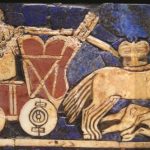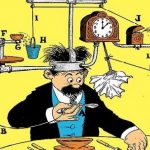 Technology
Technology  Technology
Technology  Humans
Humans 10 Everyday Human Behaviors That Are Actually Survival Instincts
 Animals
Animals 10 Animals That Humiliated and Harmed Historical Leaders
 History
History 10 Most Influential Protests in Modern History
 Creepy
Creepy 10 More Representations of Death from Myth, Legend, and Folktale
 Technology
Technology 10 Scientific Breakthroughs of 2025 That’ll Change Everything
 Our World
Our World 10 Ways Icelandic Culture Makes Other Countries Look Boring
 Misconceptions
Misconceptions 10 Common Misconceptions About the Victorian Era
 Mysteries
Mysteries 10 Strange Unexplained Mysteries of 2025
 Miscellaneous
Miscellaneous 10 of History’s Most Bell-Ringing Finishing Moves
 Technology
Technology Top 10 Everyday Tech Buzzwords That Hide a Darker Past
 Humans
Humans 10 Everyday Human Behaviors That Are Actually Survival Instincts
 Animals
Animals 10 Animals That Humiliated and Harmed Historical Leaders
Who's Behind Listverse?

Jamie Frater
Head Editor
Jamie founded Listverse due to an insatiable desire to share fascinating, obscure, and bizarre facts. He has been a guest speaker on numerous national radio and television stations and is a five time published author.
More About Us History
History 10 Most Influential Protests in Modern History
 Creepy
Creepy 10 More Representations of Death from Myth, Legend, and Folktale
 Technology
Technology 10 Scientific Breakthroughs of 2025 That’ll Change Everything
 Our World
Our World 10 Ways Icelandic Culture Makes Other Countries Look Boring
 Misconceptions
Misconceptions 10 Common Misconceptions About the Victorian Era
 Mysteries
Mysteries 10 Strange Unexplained Mysteries of 2025
 Miscellaneous
Miscellaneous 10 of History’s Most Bell-Ringing Finishing Moves
10 Surprising Facts about Sir Arthur Conan Doyle
Sir Arthur Conan Doyle is well known for creating the famous character Sherlock Holmes and has thus become, like Holmes, a name known by everyone on the planet. His famed character became truly larger than life and has inspired countless stories and characters. However, Doyle was far more than just Holmes or even the spiritualist that many are aware he forayed into later in life.
Sir Arthur Conan Doyle was a medical man, a historian, a sailor, and so much more. More importantly, he would have wanted to be known for all the other things he did and not just for creating the famous detective we all know and love.
Related: Ten Famous Writers Who Have Mysteriously Disappeared
10 A Knight of the Boer
Many people think little of the idea of knighting people just for contributing to the arts, and others believe the whole thing is a great idea. It is certainly controversial among some, and there are those who think less of those who are knighted for such things as opposed to something more “important.” Perhaps this is why, even in formal speech, few seem to bother to refer to him as Sir Arthur Conan Doyle. However, the interesting thing here is that his knighting had nothing at all to do with Sherlock Holmes, the stories about him, or anything inspired by them, directly or indirectly.
It also had nothing to do with medicine, at least not in terms of research, and nothing to do with history or his forays into Spiritualism. Rather, Doyle was knighted because he provided service to the British government during the Second Boer War (1899–1902) in South Africa. He did some work in a field hospital, but more importantly to the British government, he published a popular pamphlet in support of the Boer War.[1]
9 The Jesuits Made Me Do It
Doyle embraced Spiritualism later in life, and many are well aware of much of this already. He participated in seances, tried to prove that psychic powers were real, and even tried to confirm that the infamous Cottingley Fairies were a real thing. However, many who do know of this tend to think that this all began because Doyle was upset by the deaths of family members and was trying to get in touch with them as part of the grieving process. This may have been the catalyst for some of his later research, but the truth is Doyle had lost faith in regular religion long ago.
At the age of nine, he was sent to a strict Jesuit boarding school that still believed in harsh punishments and beatings as a way of discipline. By the time he had reached adulthood, he had given up on religion entirely. While the type of discipline he explained was common at a lot of boarding schools at the time, regardless of religion, it was certainly a rough time for young Doyle. And this had a huge effect on him.[2]
8 One Drink Too Many
Doyle is so overshadowed by his famous character that many outside Sherlockians never bother to read up too much on his biography. If they did, they would find a man who had been through a lot of unhappy periods in his life, which he got through mostly by sending letters to his mother as a form of therapy. Even worse, like many creative types who made art through adversity, his troubles started early. When he was only nine, he ended up in the boarding school in the previous entry because the whole family was basically broken up and sent away to various places by relatives protecting the kids from Daddy Doyle.
The reason for this was that his father, Charles Altamont Doyle, was an alcoholic who couldn’t properly keep his job or take care of his family. Doyle never claimed serious physical abuse at the hands of his father, but he was perfectly happy to cosign the order to have him committed later in life. He also made it clear in the Holmes novels that he did not think much of drunks and believed them to often be physically abusive. Further, he once used the name Altamont for a Holmes alias who was described as”declaring war both on the King’s English, as well as the English King.”[3]
7 An Eye-Opening Profession

Apart from writing the Sherlock Holmes stories and studying psychic phenomena and history, he was also an accomplished doctor. More specifically, he was an ophthalmologist. For those who don’t know, this is the highest level of eye doctor—outside specialists—that performs surgeries and all the most sensitive procedures. While this may not have been enough on its own to give him all the medical expertise that he would have needed to explain all the things he did in his stories, it was a bit of a different time.
Even though he specialized in eyes, as a student doctor, he learned a lot about surgery in general. As part of his hands-on studies, in order to finish his education, he spent seven months on a whaling vessel as the ship’s surgeon. It was this experience that gave him the inspiration for many of his stories with sailors, mutinies, or other ocean adventures. His ocean voyage also almost certainly inspired the story where a harpooner nails his former captain to the wall. In 1891, he started practicing medicine in London and wrote and researched all his other favorite things on the side.[4]
6 A Pretty Clueless Life
Many people would imagine that the man who invented Sherlock Holmes would have at least some of his skills of observation. After all, if Holmes could tell you what you ate yesterday and exactly what kind of cigarettes you smoke from some minor details, it is easy enough to believe that the man who created him could at least notice things like a new haircut. However, among his friends, Doyle was not known for being observant in such a manner. If anything, he was less so than the average person.
Some may have also heard of his vaunted powers of deduction and that he helped the police in some cases. The truth of this is that while he took it up as a hobby, he was rarely successful. He did help free a couple of innocent men, but that was about the sum total of his real successes. He was, however, quite good natured about this himself. He openly admitted once that he attempted to solve a case the police were working on. While they had it figured out quite quickly, all he had guessed so far was that the man was left-handed and had nails in his boot.[5]
5 That Phrenology Feeling
Phrenology is a now-debunked science and is thus considered a pseudoscience. The belief was that the shape of someone’s skull could tell you things about their intelligence, personality, racial characteristics, and the like. Many people have called this a racist pseudoscience, as it tended to portray the skull shapes of many Western races as being smarter and more capable than the skull shapes of those from places like Africa or elsewhere. Unfortunately, to his discredit, Doyle was a huge believer in phrenology.
It appears many times throughout the stories and is stated as calmly as if it were the most absolute fact in the universe—basically, as if characters who are learned men are simply talking about settled science. Now, some of you may be ready to forgive him already because it was so long ago, and we now know more than we did back then; however, the problem with this is that phrenology had been debunked before Doyle was even born. If the stories were written today, a famous medical man pushing discredited pseudoscience would be quite controversial, to say the least.[6]
4 A (Pseudo) Scientific Interest
While Sir Arthur Conan Doyle was a medical man, a historian, a failed parliamentary candidate, and so much more, he was also, more than anything, a man who wanted to be on the cutting edge of everything going on in the world. He was fascinated by all subjects, and he wanted to discover new things and be the first to believe and embrace new ideas. This meant that, like with phrenology, he was, unfortunately, an easy target for pseudoscientific beliefs that were either discredited, on the cusp of being so, or had never been considered seriously in the first place. And as these things often happen, it crept into his creative works, invading his otherwise logical detective stories.
There are actually several examples, and the first is the “Adventure of the Creeping Man.” In this story, a man takes a serum made from monkey blood in order to try to make himself younger, and he temporarily thinks and acts like a monkey because of it. In “The Adventure of the Sussex Vampire,” he uses sucking blood from a wound to stop poisoning as a key element of the story—something that does not work. These are just two examples; there are several other cases of this throughout his popular stories.[7]
3 The Racism of the Times
Doyle has been accused of being a racist, and many point to various things in his stories throughout the years, as well as his actions in life. There are the questionable things people bring up and the common defenses for them. Many people mention his unwavering support of the Boer War in South Africa, his support of phrenology, and mostly, his constant references to black people, islanders, and other non-British as grotesque, uncultured, violent, and so on. Much of this is covered by pointing out that he wasn’t much different from most people who lived during that time and probably better than some.
However, what is harder to reconcile is the way his character, Holmes, behaves in “The Adventure of the Three Gables.” In this story, a black boxer named Steve Dixie comes to intimidate Holmes at the behest of a gang leader, and Holmes makes a series of racially charged insults that would make any decent person cringe.
Worse yet, a policeman later refers to the boxer using the “N” word, and Holmes does nothing to correct this as if it is perfectly normal and okay. Some people argue that this story may have been ghostwritten and use “The Yellow Face” as evidence—arguing that the man who wrote a heartwarming tale of racial acceptance would not have written the words Holmes used against Steve Dixie.[8]
2 A Dark and Bloody Connection
Doyle was many things: a historian, a researcher, a believer in spiritualism, a former sailor, an eye surgeon, an amateur detective, a novelist, an apologist for the British government, and most of all, a curious man who wanted to explore everything there was to explore about the world he loved so much. However, there is one more thing that some people think he also was. Some also believe that Doyle, the man who created Sherlock Holmes, was secretly the serial killer Jack the Ripper.
As we mentioned earlier, Doyle spent several months on a whaling vessel in the Arctic, and during this time, some claim that he seemed to take a sadistic pleasure in the killing of the whales. People also like to point to his upbringing with an alcoholic father who visited prostitutes and all the beatings he dealt with at his hated boarding school. The theory has been dredged up more recently, with other suggestive “evidence,” including claims that the letters the Ripper sent police could have been sent on letter stock Doyle used. They had a similar style—he also alludes to the Ripper murders occasionally in his stories.[9]
1 Sherlock Holmes and the Future of Crime
Doyle was always disappointed that his work on Holmes overshadowed his psychic, medical, and historical research. However, if he knew just how much real-world good his detective novels did, perhaps looking at it today, he would not be so regretful. You see, while Holmes’s ability to figure out things like your profession may or may not be mostly a sleight of hand you can pull off in a prearranged novel, it is the rest of his methods that were of interest to the criminal justice world. Fictional or not, Holmes was one of the first ever to use things like chemistry, ballistics, and other forensic evidence to solve crimes.
This might seem so commonplace now that it is hard to imagine. Still, at the time, most cases were solved using a combination of eyewitness testimony and really, really obvious evidence—the so-called “smoking gun.” The methods used by Holmes and the popularity of his stories led to Edmund Lochard being inspired to create the world’s first forensics lab decades after the stories were written. Furthermore, pretty much all detective stories today are based both on modern crime-solving methods and on the stories and characters themselves.[10]








